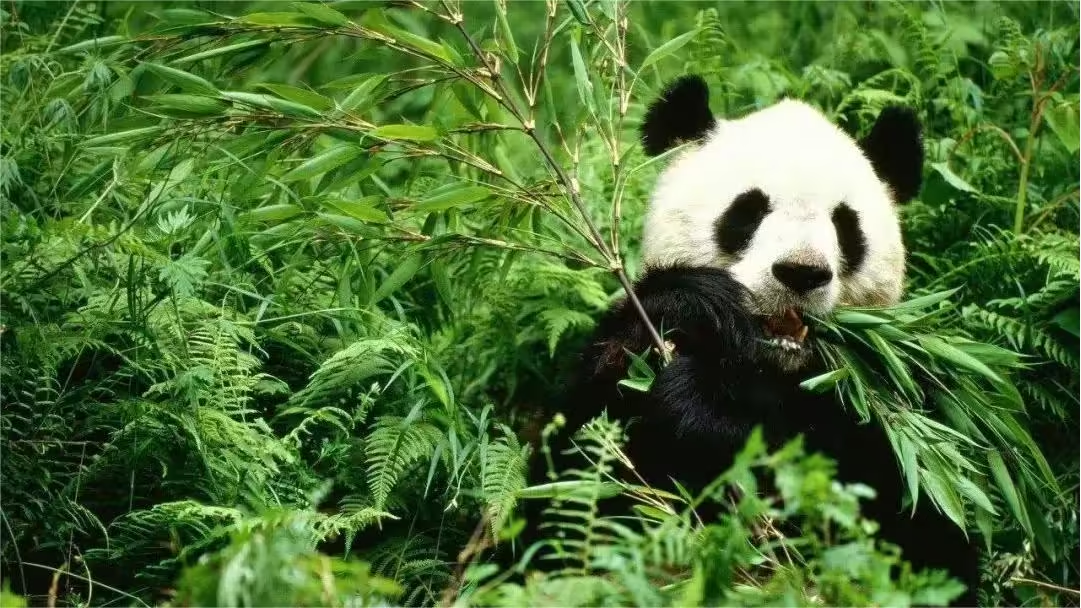Giant pandas rely on a highly specialized diet to meet their unique dietary needs, with bamboo making up around 99% of what they consume. Despite being classified as carnivores, pandas have evolved to depend almost exclusively on bamboo, choosing among the 12 genera and over 60 species available to them in the wild. These bamboo species, such as arrow bamboo, water bamboo, and black bamboo, grow in different mountain forest habitats like subalpine coniferous forests and evergreen broadleaf forests. These forests cover elevations from 700 to 3,500 meters, where pandas select bamboo varieties based on region and season.
Food Choices
Pandas’ food preferences shift with the seasons, driven by bamboo availability. In spring and summer, they prefer the tender bamboo shoots that sprout during these seasons. Shoots are nutrient-dense, soft, and relatively easy to chew and digest, making them a favorite. In the autumn, when bamboo shoots become scarce, pandas turn to bamboo leaves, which contain necessary nutrients for the cooler months. During winter, bamboo stems become the primary food source, as they remain available and accessible, although they’re harder and require more effort to consume (What Kind of Bamboo Do Giant Pandas Like to Eat?).
In addition to bamboo, pandas occasionally supplement their diet with other foods, though these make up a minor portion. They may eat fruits, vegetables, and even small animals, like bamboo rats, if encountered. However, such foods are rare in their diet and are not vital to their survival.
Foraging Techniques and Food Handling
Pandas’ adaptation to a bamboo diet is evident in their foraging behavior and the tools they’ve evolved to handle food. They spend most of their time in bamboo forests, where they can access fresh bamboo of different species and parts. Pandas are equipped with a specialized “pseudo-thumb,” an extended wrist bone that functions like a sixth finger. This unique structure allows them to grasp bamboo with great dexterity, helping them hold the stalks while stripping leaves or peeling off the outer layers to reach the tender inner shoots.
When pandas settle down to eat, they usually choose a comfortable spot near water sources. They use their strong, sharp teeth to strip the bamboo’s tough outer layer, allowing them to consume the inner, softer parts. With powerful molars, pandas can break down bamboo into smaller pieces to chew thoroughly (Why Do Giant Pandas Not Hurt Their Mouths When Eating Bamboo?). This slow, deliberate chewing is necessary because bamboo is fibrous and difficult to digest. Consequently, pandas spend a significant portion of their day — around 12 to 16 hours — foraging and eating. They consume up to 26 to 84 pounds (12 to 38 kilograms) of bamboo each day to fulfill their dietary needs. Since bamboo offers limited nutrients and energy, pandas compensate by consuming large quantities to sustain themselves.
Aside from bamboo, pandas consume other foods differently based on their texture. They drink water after eating to aid digestion, usually by licking it up. For softer foods, like fruit or rice gruel, they use their tongue to lap it up. When eating small animals or softer fruits, they use their front teeth to tear and chew.
Digestion and Absorption
Though pandas are predominantly herbivorous, their digestive systems retain some carnivorous traits, such as a simple stomach structure and a short digestive tract. This system is not optimized for digesting high-fiber plant material like bamboo, so pandas have adapted by expanding their stomach size to hold more food and give bamboo time to ferment. Panda stomachs are three times larger than those of other mammals their size, helping them store enough bamboo for gradual digestion.
Moreover, pandas have a population of gut bacteria that assists in breaking down bamboo’s tough fibers, particularly cellulose and lignin, which are otherwise challenging for their digestive systems to process. This microbial community allows pandas to extract essential nutrients from bamboo, although the process is still relatively inefficient compared to herbivores with more specialized digestive tracts.
Water intake is crucial for pandas, as they need to stay hydrated to process the high-fiber bamboo diet. After eating, they typically drink from nearby streams, ponds, or rivers. Pandas’ bodies also absorb some protein from bamboo, with protein making up 48% to 61% of their energy intake, approaching the level seen in carnivores. This is unusual for herbivores and shows that pandas’ nutritional needs are closer to those of meat-eaters, even though they primarily consume plants (Are pandas carnivores, given that they mostly eat bamboo?).




